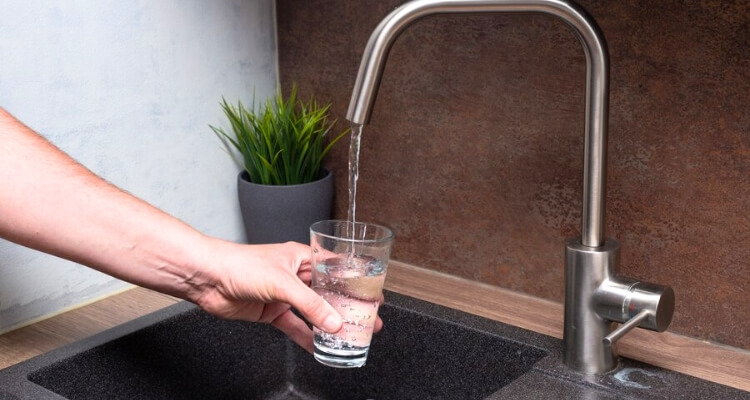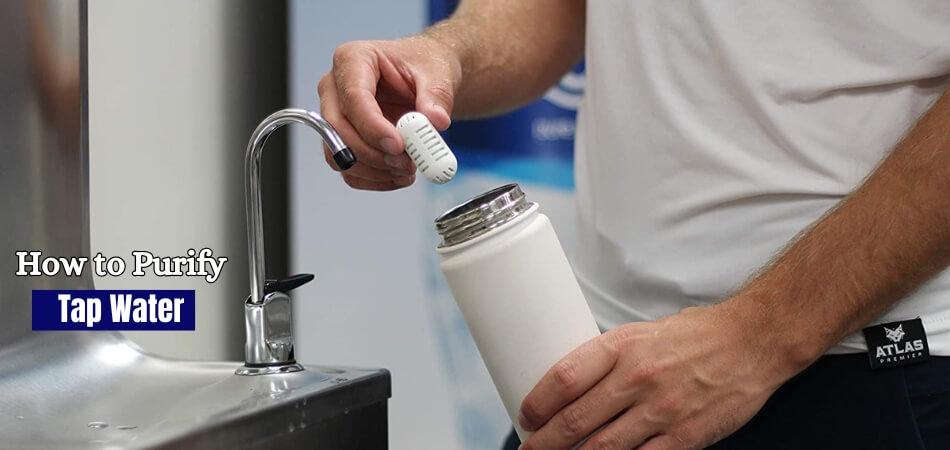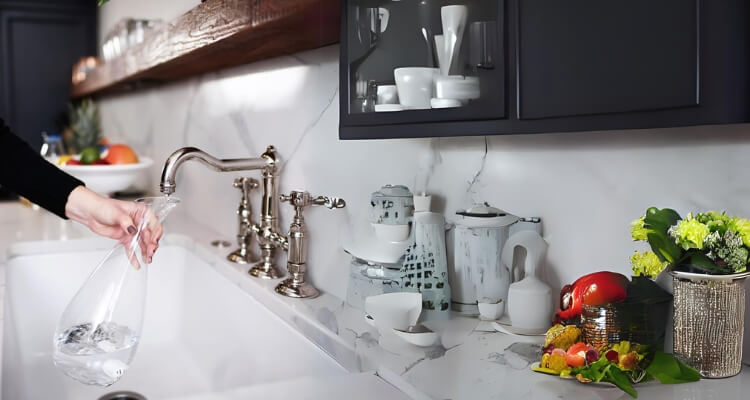The simplicity of transforming ordinary tap water into a healthy, refreshing drink is amazing. Knowing how to purify tap water effectively is more important than ever due to the increasing concerns about contaminants and pollution.
One of the simplest and most innovative solutions available is the GOpure Pod. This small, portable device can be easily dropped into your water bottle or pitcher, working tirelessly to eliminate harmful contaminants and improve the taste of your water.
This method not only offers convenience but also ensures you stay hydrated with cleaner, safer water wherever you are.
Curious to learn more about other methods and the science behind water purification? Keep reading as we fall deeper into the world of water purification.
Why Tap Water Is so Harmful?
When we turn on our taps, we expect water that is safe and clean, but this is not always the case. Despite rigorous standards in many places, tap water can still contain elements that might be harmful to our health.

Learn why tap water might not be as safe as you think, and learn how products like the GOpure Pod can help mitigate these risks.
- Chemical Contaminants: Tap water can carry a variety of chemicals like chlorine, used to kill bacteria, and fluorides, added for dental health benefits. However, excessive amounts can lead to health issues.
- Heavy Metals: Pipes and infrastructure can leach heavy metals such as lead, mercury, and arsenic into water supplies. Even at low levels, these metals can be toxic.
- Biological Hazards: Bacteria, viruses, and parasites can survive treatment processes and end up in your drinking water, potentially causing diseases.
- Pharmaceutical Residues: Modern water systems often contain traces of medications that are not entirely removed during water treatment processes. These can impact human cells and wildlife.
- Agricultural Runoff: Pesticides and fertilizers from farms can seep into water sources, introducing nitrates and other harmful substances into tap water.
- Industrial Waste: Industrial processes can discharge pollutants into water bodies that may not be completely removed during water treatment.
How to Purify Tap Water?
Purifying tap water is not only essential for taste but also crucial for your health. With a myriad of pollutants potentially lurking in your tap water, knowing how to purify tap water can significantly enhance its quality. This comprehensive step-by-step guide will help you ensure your water is safe and refreshing.

Step 1: Start with The Basics of Boiling Water
Boil your tap water for at least one minute to kill bacteria and viruses. This method is effective but does not remove chemical contaminants.
Step 2: Invest in A Quality Water Filter
Choose a water filter that suits your needs; options include activated carbon filters or reverse osmosis systems. These filters can remove chemicals and metals, improving both taste and safety.
Step 3: Use Distillation Systems
Install a home distillation system, which involves boiling water and then collecting the condensed steam. This process effectively removes impurities, including heavy metals and most chemicals.
Step 4: Consider UV Purification
UV water purifiers expose water to ultraviolet light, effectively destroying bacteria and viruses. Ensure the water is clear, as cloudy water can impede the effectiveness of the UV light.
Step 5: Chemical Disinfectants
Use chemical disinfectants like chlorine tablets cautiously. While they’re effective against pathogens, they do not remove chemical pollutants and may leave an aftertaste.
Step 6: Integrate GOpure Pod for Daily Use
For a convenient and portable option, consider using the GOpure Pod. Simply drop it into your water bottle or pitcher. It works continuously to eliminate contaminants and is ideal for on-the-go hydration.
Step 7: Regular Maintenance of Purification Equipment
Keep any water purification system well-maintained according to the manufacturer’s instructions. Regularly replacing filters and cleaning the system ensures optimal performance and water quality.
What Happens to Water When You Boil It?
Boiling water is a common practice in kitchens around the globe, serving various purposes from cooking to sterilization. This simple act of heating water, until it bubbles, has both visible and molecular effects. Knowledge of this process can shed light on the everyday phenomenon.
As the water heats up, the temperature rises, and the water molecules begin to move faster. This increased movement generates kinetic energy, leading to the formation of gas bubbles. These bubbles are the first signs that water is approaching its boiling point.
The boiling point of water is generally around 100 degrees Celsius or 212 degrees Fahrenheit at sea level. This temperature can vary slightly depending on atmospheric pressure. For instance, water boils at a lower temperature on a mountain top than at the beach.
Once boiling, water transforms from a liquid to a gas in the form of steam. This steam carries a significant amount of heat, which can be used to cook food or sterilize objects. As the steam rises, it may condense back into tiny droplets if it contacts a cooler surface.
Continuous boiling leads to the evaporation of water, reducing the volume left in the pot. If left unattended, a pot of boiling water could completely evaporate. To prevent accidents or damage, it’s crucial to monitor boiling water, especially if using high heat.
Does Boiling Water Remove Chemicals from The Water?
Is boiling water like a magic potion that can zap away all those pesky chemicals, huh? We’ll find out as we fall in!
The Boiling Point Breakdown
When you heat water, it reaches a point where it starts bubbling and turning into steam. That’s the boiling point! Now, here’s the thing: boiling water can get rid of some nasties, but not all.
Bye-bye, Bacteria and Germs!
One big benefit of boiling water is that it can kill off harmful bacteria and germs that might be hanging out there. So, if you’re worried about getting sick from your tap water, a good boil can give you some peace of mind.
Chemicals, Not So Much
But when it comes to chemicals like chlorine or heavy metals, boiling isn’t a superhero. These baddies don’t just vanish into thin air when you crank up the heat. Some might become more concentrated as the water evaporates, which isn’t what we want.
The Filter Fix
If you’re dealing with chemical contaminants, using a water filter is your best bet. Filters are like tiny superheroes that trap all the yucky stuff and leave you with clean, safe water to drink. So, while boiling can help with some things, it’s not the ultimate solution for everything.
The Benefits of Drinking Purified Water on Your Health
Have you ever wondered why purified water is considered a health elixir? Why don’t we find out what its benefits are?
- Improved Hydration: Purified water ensures you’re quenching your thirst without any unwanted contaminants tagging along. It’s like giving your body a refreshing shower from the inside out.
- Better Digestion: With impurities filtered out, your digestive system can work more efficiently. Say goodbye to bloating and discomfort, and hello to smoother digestion after each sip.
- Enhanced Detoxification: Purified water helps flush out toxins from your body, giving your kidneys and liver a helping hand in their detox duties. It’s like a gentle cleanse for your system, leaving you feeling refreshed and revitalized.
- Reduced Risk of Illness: By drinking purified water, you’re reducing your exposure to harmful bacteria, viruses, and other pathogens. It’s like building a protective shield around your health, keeping illnesses at bay.
- Clearer Skin: Purified water helps maintain your skin’s hydration levels and prevents clogged pores caused by impurities. Say hello to a clearer complexion and bid farewell to pesky blemishes.
- Enhanced Nutrient Absorption: When your body isn’t busy filtering out impurities, it can focus on absorbing essential nutrients more effectively. It’s like giving your body the VIP treatment, ensuring it gets all the goodness it needs.
- Improved Overall Health: By making purified water your hydration go-to, you’re investing in your long-term health and well-being. It’s a small yet powerful step towards a healthier lifestyle.
Is Boiled Tap Water as Good as Filtered Water?
Put your seat belts on! We’re diving into the great debate today: Is boiling tap water just as awesome as using a fancy filter? Here’s how it works!

The Boiling Point Battle
You’ve got a pot of tap water on the stove, and you’re ready to boil it. You’ll be surprised to learn that boiling water can kill off some germs and bacteria. However, that doesn’t mean there is a one-size-fits-all solution.
Filtering out The Facts
Filters, on the other hand, are like water wizards. They work their magic to remove all sorts of nasties from your H2O, from chlorine to heavy metals. It’s like having a superhero squad guarding your hydration.
What About Taste and Clarity?
Sure, boiling water might make it taste a bit better by getting rid of some impurities. But if you want that crisp, clean taste without any funky aftertaste, a filter is your best bet. Plus, filtered water often looks clearer, like liquid crystal.
Convenience Counts
Convenience is what we’re talking about. Boiling water takes time and energy, and you have to wait for it to cool before you can drink it. Turning on a faucet or filling a pitcher is all it takes to filter water.
The Verdict?
Do boiled tap waters have the same quality as filtered water? It can kill some germs, but it can’t quite match the thoroughness of a filter when it comes to removing impurities. In terms of taste, clarity, and convenience, a filter is the best choice.
FAQs for How to Purify Tap Water?
Curious about purifying your tap water? We’ve got you covered! Check out these FAQs to learn all about turning your tap water into crystal-clear refreshment.
What Do Water Filter Pitchers Remove from Tap Water?
Water filter pitchers typically remove impurities such as chlorine, lead, mercury, and other contaminants, leaving you with clean and safe drinking water.
Are Under-Sink Water Filters Effective in Purifying Tap Water?
Yes, under-sink water filters are highly effective at removing a wide range of contaminants, providing you with clean and great-tasting water straight from the tap.
How Often Should I Change the Filter in My Water Filter Pitcher?
It’s recommended to change the filter in your water filter pitcher every 2-3 months, or as directed by the manufacturer, to ensure optimal purification.
Can I Use Activated Charcoal to Purify Tap Water?
Yes, activated charcoal can be used to purify tap water by adsorbing impurities and chemicals. However, it’s best used in conjunction with other purification methods for comprehensive results.
Are There Any Natural Methods to Purify Tap Water?
Yes, you can use natural methods like sunlight exposure, filtration through sand and gravel, or using certain plants like bamboo charcoal to help purify tap water.
Last Word
We all know tap water is essential to our health, so it’s vital to ensure that it’s clean and fresh. The goal remains the same whether you boil, filter, or use innovative devices like the GOpure Pod: clean, great-tasting water.
Taking control of your hydration and health begins with knowing how to properly purify tap water. You can enjoy cleaner, safer water on the go by following simple steps like boiling water, investing in quality filters, or incorporating convenient solutions like the GOpure Pod.
Whenever you grab a drink of water, remember to purify it first. Water from the tap can be transformed into a refreshing oasis of hydration and well-being with the right methods. How to Purify Tap Water? You are on the path to better health and peace of mind when you ask this question.






